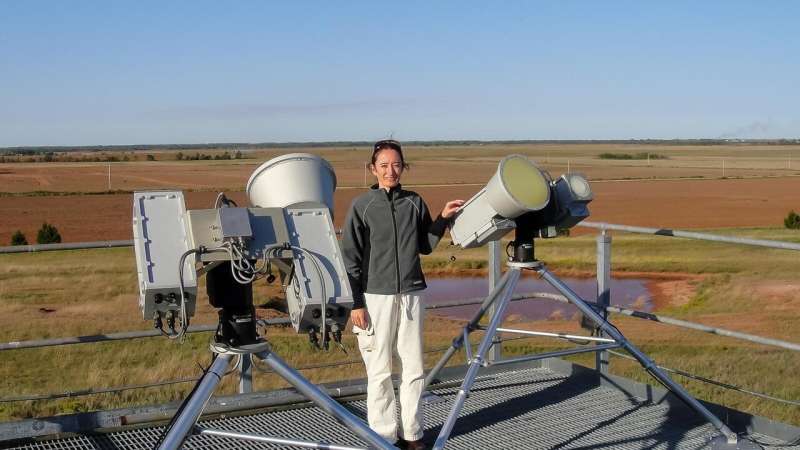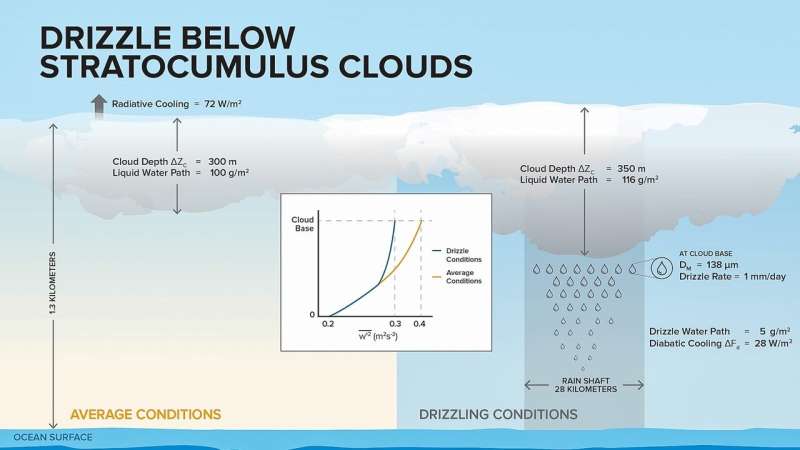Algorithm to capture drizzle-turbulence interactions could improve predictions of future climate conditions

From space, large decks of closely spaced stratocumulus clouds appear like bright cotton balls hovering over the ocean. They cover vast areas—literally thousands of miles of the subtropical oceans—and linger for weeks to months.
Because these marine clouds reflect more solar radiation than the surface of the ocean, cooling the Earth's surface, the lifetime of stratocumulus clouds is an important component of the Earth's radiation balance. It is necessary, then, to accurately represent cloud lifetimes in the earth system models (ESM) used to predict future climate conditions. Turbulence—air motions occurring at small scales—is primarily responsible for the longevity of marine stratocumulus clouds.
Drizzle—precipitation comprising water droplets smaller than half a millimeter in diameter—is constantly present within and below these marine cloud systems. Because these tiny drops affect and are affected by turbulence below marine clouds, scientists need to know more about how drizzle affects turbulence in these clouds to enable more accurate climate forecasts.
A team led by Virendra Ghate, an atmospheric scientist, and Maria Cadeddu, a principal atmospheric research engineer in the Environmental Science division at the U.S. Department of Energy's (DOE) Argonne National Laboratory, has been studying the impact of drizzle inside marine clouds since 2017. Their unique data set caught the attention of researchers at DOE's Lawrence Livermore National Laboratory.
About three years ago, a collaborator from Livermore, which led national efforts to improve cloud representation in climate models, called for observational studies focusing on drizzle-turbulence interactions. Such studies did not exist at that time because of the limited set of observations and lack of techniques to derive all the geophysical properties of concern.
"The analysis of the developed dataset allowed us to show that drizzle decreases turbulence below stratocumulus clouds—something that was only shown by model simulations in the past," said Ghate. "The richness of the developed data will allow us to address several fundamental questions regarding drizzle-turbulence interactions in the future."

The Argonne team set out to characterize the clouds' properties using observations at the Atmospheric Radiation Measurement (ARM)'s Eastern North Atlantic site, a DOE Office of Science User Facility, and data from instruments on board geostationary and polar‐orbiting satellites. The instruments collect engineering variables, such as voltages and temperatures. The team combined measurements from different instruments to derive properties of the water vapor and drizzle in and below the clouds.
Ghate and Cadeddu were interested in geophysical variables, such as cloud water content, drizzle particle size and others. So they developed a novel algorithm that synergistically retrieved all the necessary parameters involved in drizzle-turbulence interactions. The algorithm uses data from several ARM instruments—including radar, lidar and radiometer—to derive the geophysical variables of interest: size (or diameter) of precipitation drops, amount of liquid water corresponding to cloud drops, and precipitation drops. Using the data from ARM, Ghate and Cadeddu derived these parameters, subsequently publishing three observational studies that focused on two different spatial organizations of stratocumulus clouds to characterize the drizzle-turbulence interactions in these cloud systems.
Their results led to a collaborative effort with modelers from Livermore. In that effort, the team used observations to improve the representation of drizzle-turbulence interactions in DOE's Energy Exascale Earth System Model (E3SM).
"The observational references from Ghate and Cadeddu's retrieval technique helped us determine that version 1 of E3SM produces unrealistic drizzle processes. Our collaborative study implies that comprehensive examinations of the modeled cloud and drizzle processes with observational references are needed for current climate models," said Xue Zheng, a staff scientist in the Atmospheric, Earth, and Energy division at Livermore.
Said Cadeddu: "Generally, the unique expertise here at the lab is attributable to our ability to go from the raw data to the physical parameters and from there to the physical processes in the clouds. The data and the instruments themselves are very difficult to use because they are mostly remote sensors that don't directly measure what we need (e.g., rain rate or liquid water path); instead, they measure electromagnetic properties such as backscatter, Doppler spectra and radiance. In addition, the raw signal is often affected by artifacts, noise, aerosols and precipitation. The raw data are either directly related to the physical quantities we want to measure through well-defined sets of equations, or they are indirectly related. In the latter case, deriving the physical quantities means solving mathematical equations called 'inverse problems' which, by themselves, are complicated. The fact that we have been able to develop new ways to quantify the physical properties of the clouds and extract reliable information about them is a major achievement. And it has put us at the forefront of research on these types of clouds."
Because they have focused only on the few aspects of the complex drizzle-turbulence interactions, Ghate and Cadeddu plan to continue their research. They also intend to focus on other regions such as the North Pacific and South Atlantic oceans, where the cloud, drizzle and turbulence properties differ vastly from those in the North Atlantic.
More information: X. Zheng et al. A cloudy planetary boundary layer oscillation arising from the coupling of turbulence with precipitation in climate simulations, Journal of Advances in Modeling Earth Systems (2017). DOI: 10.1002/2017MS000993
Virendra P. Ghate et al. Drizzle and Turbulence Below Closed Cellular Marine Stratocumulus Clouds, Journal of Geophysical Research: Atmospheres (2019). DOI: 10.1029/2018JD030141
Virendra P. Ghate et al. Drizzle, Turbulence, and Density Currents Below Post Cold Frontal Open Cellular Marine Stratocumulus Clouds, Journal of Geophysical Research: Atmospheres (2020). DOI: 10.1029/2019JD031586
X. Zheng et al. Assessment of Precipitating Marine Stratocumulus Clouds in the E3SMv1 Atmosphere Model: A Case Study from the ARM MAGIC Field Campaign, Monthly Weather Review (2020). DOI: 10.1175/MWR-D-19-0349.1
Journal information: Journal of Geophysical Research - Atmospheres , Monthly Weather Review
Provided by Argonne National Laboratory




















